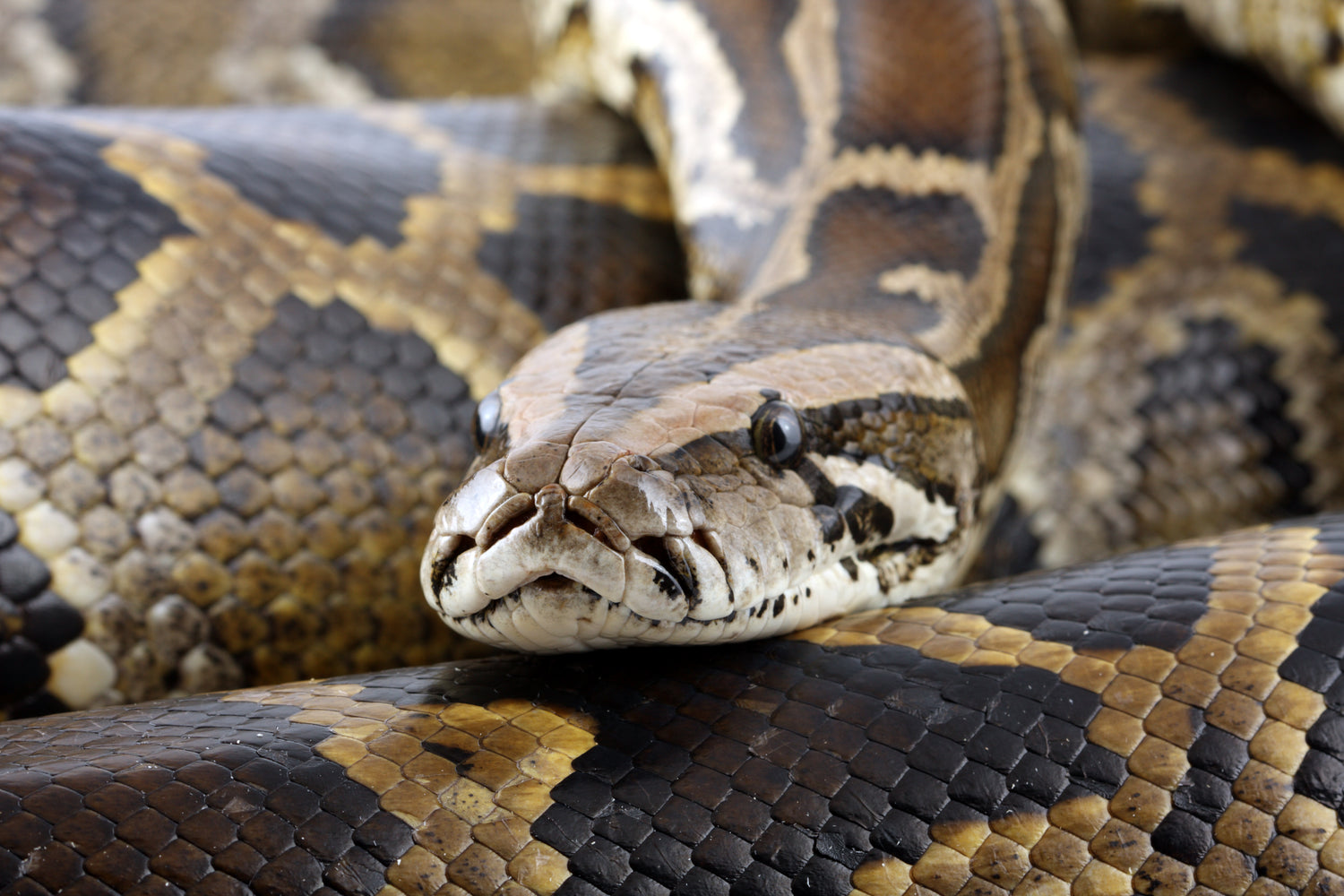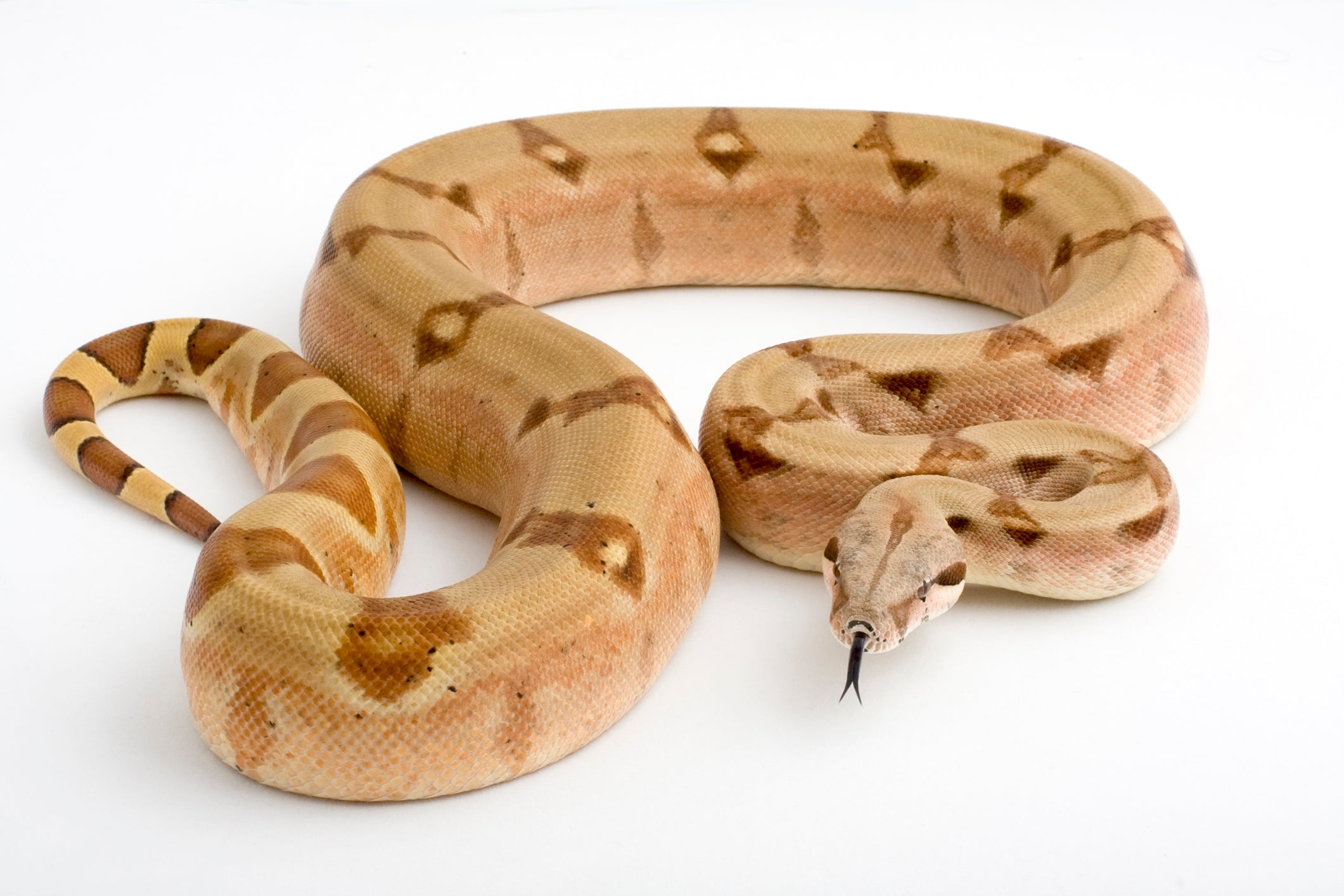Burmese pythons (Python bivittatus) are giant diurnal snakes native to southeast Asia and invasive in Florida, USA. They are highly adaptable and can be found in a variety of habitats, but they generally prefer jungle areas and grassy marshes. They are capable swimmers and climbers.
As giant snakes, Burmese pythons can grow as large as 18’ long, but they are more often between 12-16’. They have thick, muscular bodies, oval heads, large heat pits around the snout, and vertical pupils. Typical coloration is a pale grayish to gold base with brown blotches outlined in black, and a dark stripe on each side of the head from snout to ear. Captive breeding has produced alternative colors and patterns, such as granite and albino.
Burmese pythons are very popular as educational reptiles due to their immense size, but it is this immense size that makes them poor pets for all but the most dedicated and prepared keepers. They require lots of space, upkeep, and expense. Furthermore, it is essential to bear in mind that these are powerful animals capable of severely injuring and even killing humans who don’t take the right precautions!
With good care, Burmese pythons can live 20-25+ years.
How much space do Burmese pythons need?
Burmese pythons are very large animals, and as such need a very large enclosure. Although many sources will tell you that an 8’L x 4’W x 4’H enclosure is “plenty” for this species, it is important to keep in mind that a healthy Burmese python is a very active animal. Space must be provided for the snake to fully stretch out, climb, explore, and thermoregulate effectively. A more appropriate “minimum” for this species is 10’L x 6’W x 6’H, with larger being preferable — this snake’s enclosure must be at least as large as a small room or shed.
Your Burmese python’s enclosure must also be completely secured against the potential of escape. These are smart, strong animals, and are capable of breaking glass. As you design and build the enclosure, make sure that all possibilities for escape are fully addressed.
Cohabitation (keeping multiple Burmese pythons in one enclosure) is not recommended.
Do Burmese pythons need UVB?
Although Burmese pythons are diurnal, they have proven themselves able to survive without UVB lighting. That does not mean that it’s not best practice to provide it, however. Your snake needs exposure to UVB lighting for optimal health and wellbeing. Providing UVB lighting to your snake gives them all of the vitamin D that their body needs, stimulates better appetite and activity, and generally allows them to be healthier than they would be without.
The best UVB bulbs for Burmese pythons are:
- Zoo Med Reptisun T5 HO 5.0
- Arcadia Forest 6%
The UVB bulb should be half the length of the enclosure and housed in a reflective fixture like the Arcadia ProT5 or Vivarium Electronics. Place this fixture close to the heat lamp, about 11-13” above the snake’s back if over mesh, and 14-16” above the snake’s back if not. Assume that the snake is resting on its basking branch for your measurements.
For larger enclosures, it may be more prudent to use a stronger UVB bulb (Zoo Med T5 HO 10.0 or Arcadia 12%) and place the basking surface so the snake’s back will be 18-20” below the lamp. If using multiple UVB bulbs in your enclosure, it is strongly advised to use a Solarmeter 6.5 to measure UVB output so you don’t accidentally “cook” your snake. Target a basking UVI of 2.0-3.0.
Keep in mind that UVB wavelengths are blocked by glass and plastic, even when the materials are transparent. UVB bulbs decay over time, so you will need to replace your bulb(s) every 12 months to maintain good performance.
Lights should be on for 13 hours/day during summer and 11 hours/day during winter to simulate seasonal cycles. This may promote better health in your snake by stimulating natural hormonal rhythms.
What basking temperatures do Burmese pythons need?
Like other reptiles, Burmese pythons are ectotherms, which means that they need a temperature gradient in their enclosure to help them regulate their metabolism and stay healthy.
Burmese pythons prefer a basking air temperature between 90-95°F. Average daytime air temperature should be around 85°F, dropping to 75-80°F at night. Measure air temperatures with a wall-mounted thermometer near the basking surface, and another placed in the middle of the enclosure.
Provide basking heat for your snake by imitating the sun with a cluster of halogen heat bulbs placed on one side of the enclosure, positioned over a sturdy basking branch or warm hide. Use enough bulbs to evenly heat the snake’s entire body when coiled. Do not use colored bulbs, as these are not as effective. If the halogen bulbs are not enough to sufficiently heat the entire enclosure, add thermostat-controlled radiant heat panels to boost the ambient temperature.
Light-producing heat sources should be turned off at night. But if you need supplementary heating at night to hit the right temps, radiant heat panels can be used for this, too.
What humidity levels do Burmese pythons need?
Burmese pythons are a tropical species, and need an average humidity of 60-75%, as measured by a digital probe hygrometer placed in the middle of the enclosure. It’s also helpful to install a humid hide for your snake somewhere on the cool side of the enclosure, lined with moistened sphagnum moss and/or substrate. Replace the moss periodically to prevent mold.
Misting your snake’s enclosure with a sprayer or automatic misting system first thing in the morning and again at night will help create the right humidity levels. If you need more, installing a cool mist humidifier connected to a hygrostat can be helpful.
Burmese pythons like to soak and swim, so make sure to provide a tub or pool of water at least large enough to accommodate their entire body. Keep the water clean at all times, and scrub with animal-safe disinfectant once a week. It’s a good idea to connect this pool to your home’s plumbing system if possible. This pool should not be heated, and is a good way to provide the option of cooler temps to your snake.
What substrate is good for Burmese pythons?
Burmese pythons require a thick layer of moisture-retentive substrate to cushion their bodies and help maintain healthy humidity levels. As an added perk, it also tends to make the enclosure more attractive.
We recommend the following substrates for Burmese pythons:
Layering clean, chemical-free leaf litter on top of the substrate can help with humidity, and also provides extra cover for your snake to hide in as desired.
Substrate should be at least 3” deep and completely replaced every 3-4 months. Remove poop and urates daily. Contaminated substrate should also be removed and replaced.
What décor can you use in a Burmese python enclosure?
It’s terribly boring for a snake to be stuck in an enclosure with nothing in it except substrate, a branch, and a water tub. It doesn’t matter how big the enclosure is if you don’t put things in it for your pet to use and interact with.
Here are some décor ideas for enriching your Burmese python’s environment:
- thick, sturdy branches
- hides (dog kennels work well)
- ledges/platforms
- large live or artificial plants
Whatever you choose to use, make sure that the snake has plenty of cover to hide in as needed so it can feel secure in its environment.
What do Burmese pythons eat?
Like other snakes, Burmese pythons are carnivores, which means that they need to eat whole animal prey in order to get the nutrition that they need. Burmese pythons are notoriously overweight due to a tradition of feeding them far more often than they actually need. When your snake is young, offer one prey item every 1-2 weeks. As the snake grows and matures, it will need to be fed less often — let your snake’s body condition be your guide, not its behavior, as Burmese pythons are always hungry. Fasting your Burmese python once a year or so for 4 months at a time is a good way to help keep them in good condition.
Prey items should be 1-1.5x the snake’s width at its widest point. Feeder options include mice, rats, gerbils, guinea pigs, rabbits, chickens, and quail. Variety is the key to a balanced diet!
Although live prey can be used, it’s safest and most humane to use frozen instead. Prey should be thawed in a plastic bag in warm water to approximately 100°F before offering with a long pair of soft-tipped feeding tweezers. Pay attention to the snake when feeding, and keep another person in the room in case it accidentally strikes at you instead.
For safety, it’s a good idea to train your Burmese python to take prey slowly and gently rather than quickly and aggressively.
Supplements
Snakes can survive without vitamin or mineral supplements, but occasionally using them can help prevent nutritional deficiencies and optimize your pet’s health. We recommend Repashy Calcium Plus LoD.
Do Burmese pythons like to be handled?
Few reptiles actually “like” to be held, and although Burmese pythons can tame down wonderfully, it’s important to acknowledge them for what they are: large, powerful predators. They are incredibly strong, and can injure or even kill a careless human. It is important to respect them for what they are and to take appropriate precautions.
Here are some general rules for handling Burmese pythons:
- Wait at least 2 weeks before attempting to handle your new snake.
- Be gentle, and pick up the snake from below rather than from above.
- Whenever possible, allow it to climb onto you rather than grabbing it.
- Support as much of its body as possible, and NEVER pick up a snake by its tail!
- Keep handling sessions brief at first, and always end them on a positive note, with the snake acting calm.
- As the snake gets larger, make a habit of making sure at least one other person is in the room with you during handling in case of an accident. The larger the snake, the more people should be present.
- Never let your snake free-roam unsupervised.
- Never handle your snake in the same room as other pets.
*This care sheet contains only very basic information. Although it’s a good introduction, please do further research with high-quality sources to obtain additional information on caring for this species.




Leave a comment
This site is protected by hCaptcha and the hCaptcha Privacy Policy and Terms of Service apply.